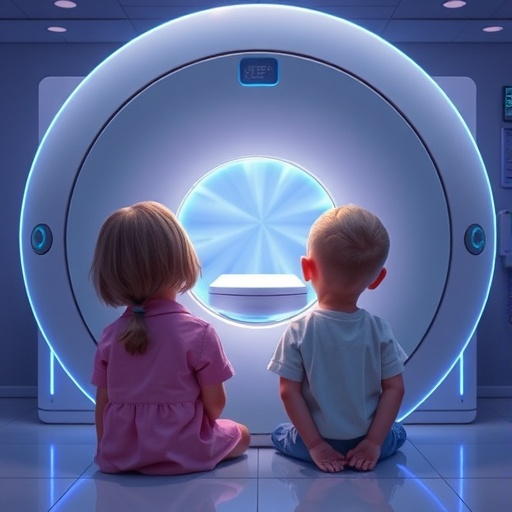Anxiety in children undergoing MRI scans is a well-documented phenomenon. This anxiety can stem from various sources including the unfamiliar environment of the MRI suite, the noises produced by the machine, and the restrictions on movement during the imaging process. Such anxiety can lead to increased motion artifacts in the images, resulting in the need for repeat scans, thereby extending the time and resources required for procedures. Thus, the implications of unresolved stress in this context reach far beyond just patient discomfort, affecting overall healthcare efficiency.
The team conducted a thorough investigation utilizing a child-friendly audio-visual intervention to help mitigate these feelings of anxiety. The intervention consisted of engaging visual stimuli paired with soothing audio tracks designed to distract children during the procedure. This multifaceted approach aimed to create a more comforting atmosphere, potentially altering the child’s perception of the MRI experience. Preliminary feedback indicated that this enhanced environment not only helped in calming the children but also potentially improved imaging outcomes by minimizing movement during the scan.
.adsslot_2bQACuP4Wr{ width:728px !important; height:90px !important; }
@media (max-width:1199px) { .adsslot_2bQACuP4Wr{ width:468px !important; height:60px !important; } }
@media (max-width:767px) { .adsslot_2bQACuP4Wr{ width:320px !important; height:50px !important; } }
ADVERTISEMENT
To assess the effectiveness of this intervention, the research team employed a randomised control trial, comparing the traditional approach to MRI procedures against their new audio-visual method. Their findings revealed significant differences in patient-reported levels of anxiety before and after the intervention. Children exposed to the audio-visual distraction reported reduced feelings of fear and panic, suggesting that thoughtful interventions can have a substantial impact on patient experience and compliance.
Additionally, the study examined the broader implications of these interventions for healthcare providers. With reduced anxiety comes the opportunity for increased operational efficiency. By decreasing the number of repeat scans due to motion artifacts, radiology departments can utilize their resources more effectively. The reduction in time spent per patient also means that healthcare providers could potentially attend to a higher volume of patients, thereby improving overall service delivery within pediatric radiology.
Another critical aspect of their findings is the subjective experience of children and their caregivers. Parents reported feeling more at ease knowing that their children had access to supportive tools designed to ease anxiety. This shift not only benefits the child’s mental well-being but also strengthens the family unit’s overall experience within the healthcare system. Empowering patients and their families to handle such health-related challenges can lead to better long-term health trajectories.
Throughout the study, researchers also noted the importance of collaboration among multidisciplinary teams in pediatric radiology. The integration of psychologists, pediatricians, and imaging professionals was pivotal in the development and implementation of the audio-visual intervention. This collaborative approach underscores the value of teamwork in addressing complex issues related to patient care in radiology, demonstrating how diverse expertise can lead to better outcomes.
This research does not merely contribute to the field of pediatric radiology; it opens up dialogues across disciplines about the importance of patient-centered care. Addressing anxiety is not just a means to improve imaging accuracy; it is an essential aspect of enhancing the overall quality of healthcare experiences for young patients. The evidence presented in this study could drive the development of policies emphasizing anxiety management as a standard part of pediatric care protocols.
Furthermore, these findings can be instrumental in informing the design of MRI suites and protocols in the future. By understanding the characteristics that foster a calming environment for children, hospitals may better equip their facilities to cater specifically to young patients. This forward-thinking approach to hospital design can ensure that comfort and support are inherent in the healthcare experience.
As we delve deeper into the implications of this research, it becomes evident that integrating technology in healthcare is not simply about advancing equipment or procedures but also about enhancing the human experience in these clinical settings. The audio-visual intervention exemplifies how creative solutions can lead to deeply improved healthcare encounters, especially for vulnerable populations.
The significance of this research extends beyond the immediate implications of comfort in MRI procedures. It underlines a growing recognition within the medical community of the impact of psychological factors on health outcomes. Addressing patient anxiety can lead not only to better patient satisfaction but also potentially more accurate diagnoses and effective treatment plans in the long run.
In summary, the exploration of audio-visual interventions in pediatric MRI procedures by van der Vleuten-Chraibi and colleagues highlights a necessary shift towards more compassionate healthcare. By placing the emotional and psychological needs of children at the forefront of clinical practice, the healthcare community is not only advancing medical technology but also ensuring that the humanity within healthcare is preserved and enhanced.
Through comprehensive research and innovative implementation, the study offers a glimpse into a future where healthcare practices prioritize the well-being of patients as a pivotal part of medical care. This integration of comfort, technology, and patient-centered approaches represents a promising journey towards more effective and empathetic healthcare systems for children.
Subject of Research:
Article Title:
Article References:
van der Vleuten-Chraibi, S., Nauts, S., Barańska, D. et al. Magnetic resonance imaging related anxiety and workflow: impact of a child-friendly audio-visual intervention.
Pediatr Radiol (2025). https://doi.org/10.1007/s00247-025-06308-0
Image Credits: AI Generated
DOI: https://doi.org/10.1007/s00247-025-06308-0
Keywords:
Tags: addressing motion artifacts in MRIalleviating anxiety in young patientschild-friendly audio-visual interventionseffective interventions for pediatric imaging anxietyenhancing patient comfort during MRIimaging studies in childrenimpact of anxiety on MRI accuracyimportance of child-centered healthcareinnovative pediatric care solutionsoperational efficiency in radiology departmentspediatric MRI anxiety reductionstrategies for managing anxiety in children





